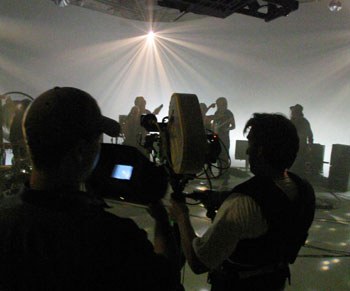"EMVF in 65mm: Movies for Your Ears" |
Read more
at in70mm.com The 70mm Newsletter |
| Written by: James Tavella, film producer | Date: 1 February 2005 |
|
|
Further
in 70mm reading: "EMVF in 65mm: Movies for your ears" - GO TO GALLEY A recent 65mm Production Panavision story Super Panavision 70 films Cast and credits Internet link: Full Resolution Entertainment |
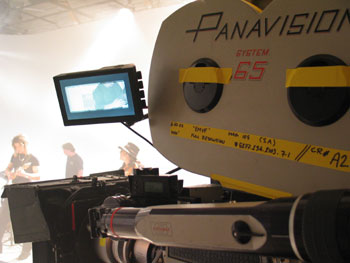 The
only format that came to mind was IMAX. However, in order to garner
any interest from IMAX on such an ambitious project, we realized that some
kind of forerunner or preview was required to show and express the value of
this story to be told in such a large format. Depth and clarity of
picture was essential and the only way to accomplish that for "EMVF
in 65mm: Movies for Your Ears"
was in 70mm. The
only format that came to mind was IMAX. However, in order to garner
any interest from IMAX on such an ambitious project, we realized that some
kind of forerunner or preview was required to show and express the value of
this story to be told in such a large format. Depth and clarity of
picture was essential and the only way to accomplish that for "EMVF
in 65mm: Movies for Your Ears"
was in 70mm. |
James F
Tavella FULL RESOLUTION ENTERTAINMENT (818) 335-5326 (818) 364-6263 fax filmcreations@yahoo.com jtavella@fullresolution.com PO BOX 2179 TOLUCA LAKE CA 91610 USA |
 Producer
James Tavella. Producer
James Tavella. |
|
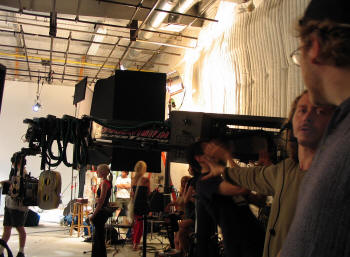 Director
Bruce Sears and producer James Tavella discuss an up and coming setup
involving the Technocrane system. Photo by Mako Kowai Director
Bruce Sears and producer James Tavella discuss an up and coming setup
involving the Technocrane system. Photo by Mako KowaiWe additionally realized that a musical group capable of orchestrating such a soundscape composition for this preliminary vision was needed. This broad sound ironically came not from a large orchestra but from a 4 piece symphonic musical group. The group was EMVF led by musical director and accomplished Warr/Bass guitarist Michael Hamernik and consisted of guitarist Steve Chandler; electric violinist Jeff Sullivan; & percussionist David Sears. |
|
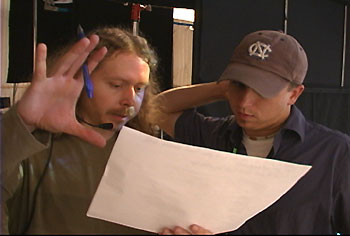 Director
Bruce Sears (left) discusses with Cinematographer Neil Moore (right)
blocking for steadicam Director
Bruce Sears (left) discusses with Cinematographer Neil Moore (right)
blocking for steadicamTogether with the other executive producers, we began discussions with Panavision: Woodland Hills & Kodak in Hollywood. Both companies eagerly jumped on the project & donated their services. Panavision loaned all five of their 65mm cameras to the shoot & Kodak donated all stock in 5298 & 5277. Out of the total camera packages, both System 65 cameras originally designed to shoot “Far & Away” & one handheld pellicle 65 would end up being chosen for the times on set. |
|
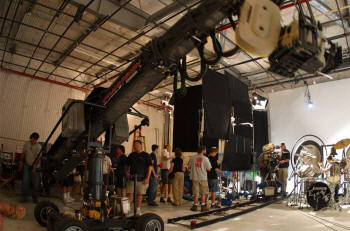 Some
of the crew. Photo by Rodney Lockett Some
of the crew. Photo by Rodney LockettPress for enlargement In preproduction, Bruce knew that a highly capable DP would have to be brought in who knew how to expressively light large format. After much review, he found that quality & skill in Cinematographer Neil Moore. Neil offered an unmatched ambition along with a truly creative look. He in turn teamed up with veteran gaffer Foster Denker. |
|
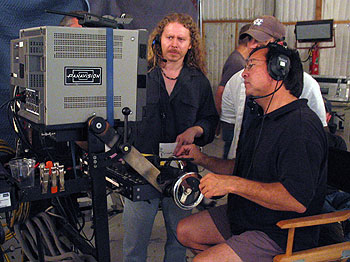 Mako
(Makofoto) operates the technocrane camera as Director Bruce Sears watches.
Photo by Matt petrosky Mako
(Makofoto) operates the technocrane camera as Director Bruce Sears watches.
Photo by Matt petroskyDuring preliminary discussions, we all understood that the scope of the original story had to be greatly downsized & centered more towards the individual elements of the design of the original script. The decision was made to detail more of the soundscape involved in telling the story-a large sound to accompany a large format. One of the executive producers made the decision that in order to show the musical group’s versatility we should shoot them playing live. This added a whole new level of production decisions that increased the burden on the Director and the Production. So in a short period of time, as is typical in productions, we went from a 65mm concept preview to a live multicamera shoot; but we were up to the challenge. Bruce designed an animatic preview script as well as several contingency plans for this challenge knowing full well that shooting live would be more like live switching than a multiple take shoot. |
|
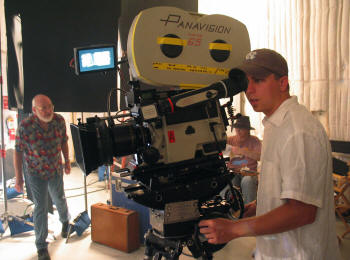 Director
of photography Neil Moore views a setup on the System 65 "A" camera.
Photo by Matt Petrosky Director
of photography Neil Moore views a setup on the System 65 "A" camera.
Photo by Matt PetroskyPress for enlargement The limited film stock also challenged him to be required to call roll & cut live during continuous camera coverage as well as live lense changes to accomplish his vision. The vision for this film became one surrounding our new cast which was the four musical members. Each member would have his own theme & scene lasting between about 4 min & all coverage would revolve around telling his story for that scene. Since the original 60 min screenplay involved creation, we chose to give each member a symbolic reference to creation based on the elements-earth, wind, fire & water. Earth would be the foundation which was the percussionist; wind would be the violinist who was able to bend & lead the music or spiritually follow it at will; fire would be the guitarist based on his ability to burn through the soundscaping & change its direction; & water would be the bassist whose sound flowed along side the percussionist & melded with him. With the focus now on evolving a story around the musicians, extensive discussions began between Bruce & Neil about the design of the lighting. |
|
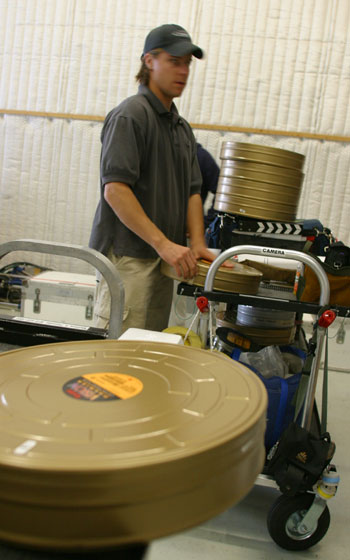 James
Dickson, 65mm & CircleVision SFX specialist, joined the team
& was a great help in preparing us for the requirements of lighting &
lensing 65mm. The thought was to try & use the old anamorphic 65 lenses to
achieve a 2.75 ratio but we discovered that the remaining three “Ben
Hur” Panavision lenses had fungus growing on the glass & weren’t
usable. So the decision was made to frame for 2.40 with the idea of being
able to project this as a combination of a promo for a larger story either
standing alone or as a pre-show instructive piece about the synergy of
picture & sound shown before a film’s trailer. Bruce & Neil decided on a
look specific to each member. Since live switching & playback would not be
possible, the use of two continuity supervisors was added as a safety &
each camera would be monitored at video village. I set the production up
with a crew of 40 & Sal Gomez, AD, scheduled a 3-day shoot. James
Dickson, 65mm & CircleVision SFX specialist, joined the team
& was a great help in preparing us for the requirements of lighting &
lensing 65mm. The thought was to try & use the old anamorphic 65 lenses to
achieve a 2.75 ratio but we discovered that the remaining three “Ben
Hur” Panavision lenses had fungus growing on the glass & weren’t
usable. So the decision was made to frame for 2.40 with the idea of being
able to project this as a combination of a promo for a larger story either
standing alone or as a pre-show instructive piece about the synergy of
picture & sound shown before a film’s trailer. Bruce & Neil decided on a
look specific to each member. Since live switching & playback would not be
possible, the use of two continuity supervisors was added as a safety &
each camera would be monitored at video village. I set the production up
with a crew of 40 & Sal Gomez, AD, scheduled a 3-day shoot. |
|
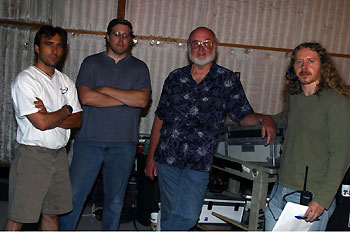 John
Radzik (Stedicam Operator), James Tavella (Producer), Jim Dickson (65mm
specialist) and Bruce Sears (Director). John
Radzik (Stedicam Operator), James Tavella (Producer), Jim Dickson (65mm
specialist) and Bruce Sears (Director).Photo by Rod Lockett During production the single location, Panavision Stage 1, was lit by Neil to give the sense of a surreal, ambiguous atmosphere that focused on the musicians while at the same time providing depth & ambiance. The use of fog enhanced this vision. One system 65 would be flown on a 30 ft Technocrane provided by Andy Romanoff of Panavision Remote Systems & operated by Mako Koiwai, the second system 65 would track on dolly & the handheld pellicle would shoot coverage on steadicam operated by John Radzik. Both the crane & the steadicam would have a 40mm (for the steadicam it was an issue of weight). |
|
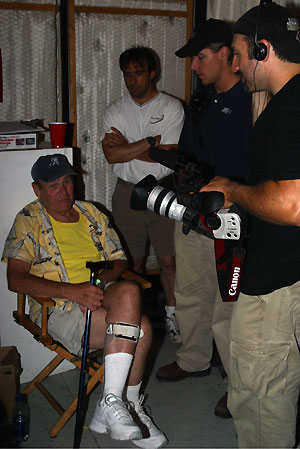 Art
Douglas (right) interviews Don Earl (Panavision). Photo by Rod Lockett Art
Douglas (right) interviews Don Earl (Panavision). Photo by Rod LockettThe dolly camera would be switched live in shot between a 75mm & a Zeiss 300mm. Since no control trailer was available, the video village was constructed on the noisy set & communication between the director & the camera crew was maintained using headsets. Once Bruce called “action” the cameras performed beautifully. All cameras were rolled & cut live to preserve film with each camera positioned to cover a specific action in shot. We rolled through footage with the director calling “cut” once he felt like he had enough coverage to satisfy the scene. The shooting script was designed to be organized and give freedom to improvise as needed. Principal photography consisted of two days with one day each for two musicians. During that time, the crew worked magnificently and a high constant moral was always maintained on-set. We were encouraged & thrilled by the visit of Don Earl on set during principal & it gave us added motivation to be true to the history of these cameras in our behind the scenes documentary. |
|
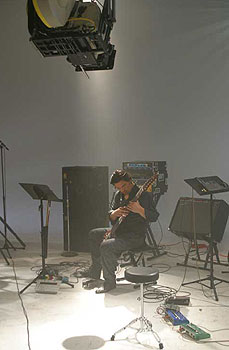 Postproduction would be handled by CFI for processing. This shoot has lead
to much interest from the New York Film Festival & several magazines &
newsletters. We are proud to be included in the In70mm.com - The 70mm
Newsletter & website & hope we have an opportunity to screen this piece at
the the widescreen
weekend in Bradford. Postproduction would be handled by CFI for processing. This shoot has lead
to much interest from the New York Film Festival & several magazines &
newsletters. We are proud to be included in the In70mm.com - The 70mm
Newsletter & website & hope we have an opportunity to screen this piece at
the the widescreen
weekend in Bradford. |
|
|
Go: back
- top -
back issues
- news index Updated 21-01-24 |
|

